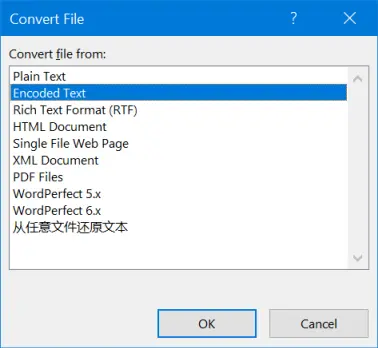

- #HOW TO CHANGE ENCODING IN WORD MANUAL#
- #HOW TO CHANGE ENCODING IN WORD SOFTWARE#
- #HOW TO CHANGE ENCODING IN WORD CODE#
- #HOW TO CHANGE ENCODING IN WORD ISO#
You either are lucky, or you need to do this manual step. Now it's just working as it's supposed to: with manual extra work of guiding the editor. Everything worked out for you by lucky assumption. There is nothing wrong in your computer, nor in your text files. Maybe simplistic (headerless, metadataless) formats such as. Now we have been in a fuzzy area again, but it seems this will be less of an issue as time goes by and everybody's just using UTF-8. We (Scandinavian countries) had our de-facto assumed character encodings between about 1995 to about 2010, which worked fairly well. However, about every 20 years, the assumptions change.
#HOW TO CHANGE ENCODING IN WORD SOFTWARE#
txt file, or, 2) Assume, possibly using an operating system wide setting To make everything appear easy, software designers often choose 2), especially for simplistic programs like MS Notepad. txt file are: 1) Ask the user every time you open a. txt format doesn't tell which character set it uses! So, the only ways they have when opening your. txt format does not convey what the binary values mean - i.e., the. Also obviously, you should select "Swedish" or "Svensk" or whatever it's called in your version. Inside this dialog, there is a checkmark "Beta: UTF-8 support" which has to be unchecked. Inside there (rightmost tab) there is a setting for "Unicode incompatible programs" which allows to change your location/language setting.

There is a "Time and Region" setting there (sorry, translated back from my German version) with a "Region" selection inside. Before messing around with changing the registry, you could try to fix this using the system control panel.
#HOW TO CHANGE ENCODING IN WORD CODE#
So it's obviously encoded in/for code page 850. Your text file is displayed correctly on my Win 10 machine btw. People report that changing this entry (to something invalid or Unicode) might stop Windows from booting though. If it's not 850 on the problem machine, this is most probably the culprit. Did you try to check the registry entry (with RegEdit)? HKEY_LOCAL_MACHINE\SYSTEM\CurrentControlSet\Control\Nls\CodePage\OEMCP The value is 850 for me and I bet it's the same on your "working machines". So there is a certain chance that the OEM code page is set wrong on this single machine. Languages like Java used UTF-8 at least 15 years ago. all source code created with somewhat modern tools like Eclipse are UTF-8. You might not be aware of this, but since (at least) ten years or so, UTF-8 is the de facto standard for text files. The most future safe approach would still be to convert your files to UTF-8. but it should be your last resort as it can cause any kind of issues. For me, it's set to 850 which explains why I can still open 8bit ANSI text files which were created for/with code page 850. Then you could check the default oem code page set in the registry (HKEY_LOCAL_MACHINE\SYSTEM\CurrentControlSet\Control\Nls\CodePage\OEMCP). So first of all you need to find out which code page was used to create these files.
#HOW TO CHANGE ENCODING IN WORD ISO#
I have a very few text files which seem to be encoded in ISO 8859 which are not displayed correctly in Notepad/Wordpad. in these files, the German "ä" is encoded 0x84. Most of my very old text files use the Western European codepage 850 though which is still displayed correctly in Notepad and Wordpad under Windows 10. Anyway, as German shares most of the Swedish diacritics (apart from "Å" I believe), we're in the same boat. It should contain all the needed diacritics.

Besides, I wonder why the default Wester Europe code page 850 wouldn't work for Sweden. My understanding was that the console is supposed to use a byte based code page for backward compatibility. It's actually surprising that yours shows an UTF-8 Unicode codepage. which is/was the Western Europe code page in times before UTF-8. IMHO, "chcp" just shows (or allows to change) the codepage that the (current) console (!) is using.


 0 kommentar(er)
0 kommentar(er)
